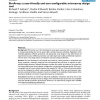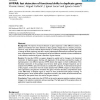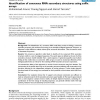BMCBI
2006
13 years 11 months ago
2006
Background: The accuracy of protein secondary structure prediction has been improving steadily towards the 88% estimated theoretical limit. There are two types of prediction algor...
BMCBI
2006
13 years 11 months ago
2006
Background: Microarrays were first developed to assess gene expression but are now also used to map protein-binding sites and to assess allelic variation between individuals. Rega...
BMCBI
2006
13 years 11 months ago
2006
Background: Protein phosphorylation is an extremely important mechanism of cellular regulation. A large-scale study of phosphoproteins in a whole-cell lysate of Saccharomyces cere...
BMCBI
2006
13 years 11 months ago
2006
Background: Many genome projects are left unfinished due to complex, repeated regions. Finishing is the most time consuming step in sequencing and current finishing tools are not ...
BMCBI
2006
13 years 11 months ago
2006
Background: The imprint of natural selection on gene sequences is often difficult to detect. A plethora of methods have been devised to detect genetic changes due to selective pro...
BMCBI
2006
13 years 11 months ago
2006
Background: Successful realization of a "systems biology" approach to analyzing cells is a grand challenge for our understanding of life. However, current modeling appro...
BMCBI
2006
13 years 11 months ago
2006
Background: The identification of a consensus RNA motif often consists in finding a conserved secondary structure with minimum free energy in an ensemble of aligned sequences. How...
BMCBI
2006
13 years 11 months ago
2006
Background: Methods for predicting protein function directly from amino acid sequences are useful tools in the study of uncharacterised protein families and in comparative genomic...
BMCBI
2006
13 years 11 months ago
2006
Background: The design of oligonucleotides and PCR primers for studying large genomes is complicated by the redundancy of sequences. The eukaryotic genomes are particularly diffic...



